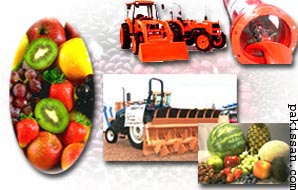|
Agri models for higher productivity
Noor Ahmed Nizamani
Many new models, machines and methods are being put to use to achieve high agricultural productivity in various Asian countries. 
When one looks at Thailand's agriculture, there are bumper crops of rice, corn, sugar cane and many kinds of fruits and vegetables. The size of guava is so large, only one can be held in one hand. Imagine Karela the size of a long loki. Pineapple, watermelons, lychies, mangoes, bananas are produced in plenty. Thailand is a fruit-land. A Thai university professor said that the large guava seed was brought from Vietnam and a new variety of seedless guava will be released for plantation next year.
Recently, a 5-day seminar on agricultural models for higher productivity was organized by Japan supported the Asian productivity organization (APO) at Bangkok which was participated by 13 delegates who were from Bangladesh, Nepal, India, Sri Lanka, South Korea, Taiwan, Pakistan, Singapore, Thailand, Malaysia, Iran, Fiji Islands and Mangolia.
Ms Rukhsana Malek (Bangladesh) spoke about a successful system of urea fertilizer use in crops. Researchers have developed urea in the form of urea super granule (USG) deeply placed in fields at a certain distance. In Bangladesh, USG made by compressing ordinary urea into briquettes of approximately one gram (USG) and three gram USG (mega granule) by a briquettes machine which is locally fabricated, is a popular fertiliser. These machines are being exported.
The Thai delegate informed about a farmer who has succeeded in organic agriculture. In trying to go for organic agriculture, one faces many problems like low quality of soil structure, scarcity of plant nutrition, lack of knowledge about plant protection and marketing. The farmer took byproducts from rice and the waste of animal farms and from vegetables to improve soil structure. He increased plant nutrition by a process which depends on fermentation of anaerobic bacteria. The raw materials were molasses, byproducts of crops, protein sources from fish and livestock. The ratio of molasses; raw material is 1:3 in weight.
The process of fermentation gives a solution called BE - (bio- extract). This liquid is source of minerals, trace elements and some growth regulator hormone. For plant protection, he used the same process. The raw materials were molasses: herbal 1:3 by weight, for example, 1kg of molasses: 3kg of chilli in liquid form for control of aphid. The marketing problem was solved by making contract with a company that sells organic food.
In Malaysia, agriculture contributes about 10 per cent of the GDP. Its delegates, Dun Zabidi and Leong Poh Lew presented their separate papers. Zabidi said that many people in farming community are getting old and are leaving their lands and orchards. He contacted people who would take over these lands by entering into a contract with the owners and pay 40 per cent profit to them.
Ms Khoo Gek Hoon, the delegate from Singapore, provided a rosy picture about the vegetable production and agrotechnology parks there. There are different production systems adopted for leafy vegetable production, generally categorized under soil cultivation and hydroponic systems. Soil cultivation includes the use of conventional methods and organic farming while the hydroponics include the use of aeropoic and dynamic root flow (DRF) systems.
The vegetable farms are monitored for pesticides by various food safety authorities. These farm produce are graded, trimmed and packed for sale for higher profit in highly competitive market. To ensure freshness of vegetables, good handling post harvest and cold storage practices are adopted.
Precision agriculture - use of Geo-Informatic Technology in farming was presented by Somjate Pratummintra, from the department of agriculture, Thailand.'Precision agriculture' is about the optimum land utilization types, taking into account, both physical and socio-economic consideration and the conservation of environmental resources.
The geo-informatic technologies are composed of the geographic information system (GIS), remote sensing and digital image analysis technology, global position system (GPS). It means that the GIS is used to manipulate the database (topology, storage etc.) and to analyse and display the results, while the remote sensing technique is applied to interpret the land cover type.
The area is located with a GPS. Then the special data is taken by using the cartography. On the other hand the crop model is applied to predict the maximum production potential and evaluate limitation parameters for crop production. The actual land productivity is studied and used for planning. The good agricultural practice is adopted for improving the limitation parameters to increase the land productivity.
The cooperative and the contract system models were also discussed at length and the general consensus was that both models can succeed if they work under a regulatory body with representatives from government, farmers and buyers and from civil society.
Courtesy Dawn
|
Pakissan.com;
|